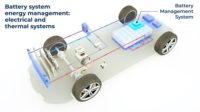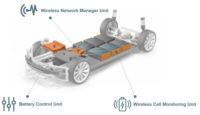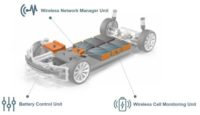TI Unveils Wireless Battery Management System

DALLAS—Texas Instruments Inc. (TI) has unveiled a wireless battery management (BMS) system for electric vehicles. It enables automotive engineers to streamline electrical architectures, simplify packaging, and reduce weight by eliminating bulky cabling and wiring harnesses.
“Wireless BMS empowers [engineers] to reduce the complexity of their designs, improve reliability and reduce vehicle weight to extend driving range,” says Karl-Heinz Steinmetz, general manager for automotive power train systems at TI. “With the flexibility to scale designs across production models, automakers can advance to production faster.”
“The implementation of wireless battery management systems will be a growing trend in the EV marketplace, because these advancements provide greater flexibility of design while also lowering the complexity and cost relative to traditional systems,” adds Asif Anwar, director of the powertrain, body, chassis and safety service at Strategy Analytics Inc. “By demonstrating a solution that combines these advantages with ASIL D compliance, the TI [system] sets a benchmark for the industry to follow.”
“Rivaling wired connections, [our wireless BMS] via the SimpleLink CC2662R-Q1 wireless MCU offers the industry’s highest network availability of greater than 99.999 percent and a network restart of 300-ms maximum availability,” claims Steinmetz. “With this wireless MCU, dedicated time slots that provide high throughput and low latency protect data from loss or corruption, while enabling multiple battery cells to send voltage and temperature data to the main MCU with ±2-mV accuracy and a network packet error rate of less than 10-7.
“Wireless BMS technology takes the wiring harness out of the equation,” explains Steinmetz. “It simplifies assembly by reducing complexity and manufacturing costs. Wireless BMS also results in significant weights savings that can range from 75 to 200 pounds per vehicle.”
Anticipating automakers’ long-term design needs, TI claims that its wireless BMS technology is the most scalable in the industry.
“The deterministic protocol provides the highest throughput in the market, enabling [automotive engineers] to create a battery module using a single wireless system-on-chip connected with multiple BQ79616-Q1 battery monitors for different configurations such as 32-, 48- and 60-cell systems,” says Steinmetz. “The system is designed to support up to 100 nodes with the industry’s lowest latency of less than 2 ms per node and time-synchronized measurements across every node.
“The CC2662R-Q1 wireless MCU isolates individual cell monitoring units, eliminating the need for and cost of daisy-chain isolation components,” Steinmetz points out. “The BQ79616-Q1 battery monitor and balancer offers different channel options in the same package type, providing pin-to-pin compatibility and supporting reuse of the established software and hardware across any platform.”
“Security is important to wireless systems, so our protocols are state of the art,” adds Ram Vedantham, 2.4 GHz business line manager for connectivity at TI. “Security is built into every layer of our wireless BMS.
“Using a protocol developed specifically for the wireless BMS, [our] functional safety concept addresses communication error detection and security,” explains Vedantham. “The proprietary protocol via the CC2662R-Q1 wireless MCU enables a robust and scalable data exchange between a host system processor and the BQ79616-Q1 battery monitor and balancer.”
Other automotive suppliers, such as Visteon, are also developing wireless battery management systems. Click here to learn more.
Looking for a reprint of this article?
From high-res PDFs to custom plaques, order your copy today!






